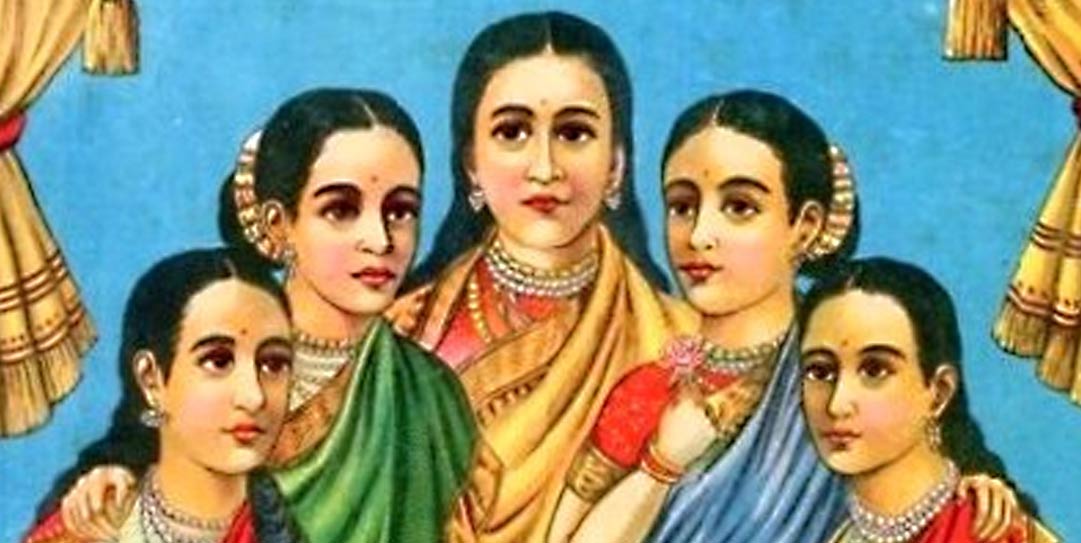
The Legends of the Panchakanya - The Five Virgins of Ancient India
The Panchakanya (the five virgins) are female characters in the two great epics of India, Ramayana and Mahabharata. Each of them is described as extraordinarily beautiful and virtuous. The literal meaning of 'kanya' means ‘girl’, ‘maiden’ or 'virgin'. Although the five women are all married, sometimes with multiple men, this was the word chosen to depict them instead of the word nari (woman) or sati (chaste wife), which was then questioned by scholars. However, the word was chosen because tradition says that the purity of their characters are so strong, that nothing could corrupt their spiritual powers. In fact, their very names are believed to ensure salvation and freedom from evil. It is not uncommon, therefore, for devout Hindu to recite their names each morning to remind them of the power they symbolized.
The chant is sung like this: Ahalya Draupadi Sita,Tara Mandodari tatha, Pancha kanya smarenityam, maha pataka nashanam, which means "Mediating on the merits of the five great virgins, namely Ahalya, Draupadi, Sita, Tara and Mandodari, helps destroy even the greatest of sins”
The Five Forms
The Panchakanya are Ahalya, Draupadi, Sita, Tara and Mandodari. In a lot of traditions, Sita is replaced with Kunti as the third lady of the Panchakanya. Ahalya, Tara, Mandodari and Sita are from Ramayana, while Kunti and Draupadi are from Mahabharata. Although Kunti and Sita are interchangeable, to keep the formation of the five virgins, they would never appear together as they represent the same natural element, which is earth.
Five is one of the mystical numbers according to Hindu belief. There are five ingredients prescribed for worship: wine, fish, flesh, lard and chant, corresponding to the five senses in the human body: taste, smell, sight, touch and hearing. It is also believed that nature manifests itself in five forms: earth, water, fire, wind and sky. Each kanya is born of one of these elements, and these five elements of nature formed the essence of their characters.
The Five Legendary Ladies
The first kanya is Ahalya, who was born of water. Brahma created her from all things beautiful, to be the symbol and carrier of beauty.
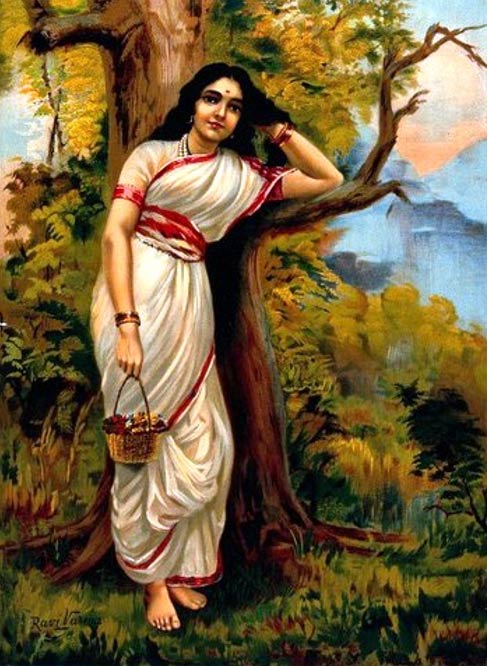
Ahalya leaning on tree. (Public Domain)
Ahalya was placed in the care of the elderly sage Gautama until her puberty. She was then given by Brahma as a wife to Gautama, to whom she was devoted. After marrying Gautama, Ahalya settled into his hermitage in a forest near Mithila, where the couple practiced asceticism together. But, Indra, the king of the heavens, wanted her for himself.
One night, as Gautama and Ahalya lay sleeping, Indra disguised himself as a cock and crowed. Gautama thought it was dawn and went for his meditation near the river. Indra then disguised himself as Gautama himself, and ravished Ahalya. Gautama, on his way to the river, became aware of the deed, and at once returned to his hermitage. In his rage, he cursed Indra to lose his testicles. Ahalya, whose only sin was of surrendering herself to the one she thought to be her husband, was also cursed. Gautama cursed Ahalya to remain invisible to all beings for thousands of years, to fast by surviving only on air, to sleep in ashes and to be tormented by guilt. As Ahalya was starting to fade, Gautama abandoned her to go to the Himalayas. Thousands of years later, the God-King Rama, seventh reincarnation of Vishnu, passed Gautama's desolate hermitage while traveling to the court of king Janaka in Mithila. As they neared the hermitage, his teacher Vishvamitra recounted the tale of Ahalya's curse. Vishvamitra described her as goddess-like and illustrious. Rama and his companions felt her presence, as instead of slipping away to cry over her dishonor, she stood firm, staying in the very ashram where she was shamed and carrying on her good work despite her lack of physical presence and society’s censor. Due to her patience and the intensity of her ascetic devotion, Ahalya was described as glowing, but hidden from the world like the sun obscured by dark clouds.
Rama then entered the ashram to see Ahalya, who, up till then, had been hidden from the universe. Rama came to her side and declared her blameless in this incidence. In the end, Gautama came back to her.
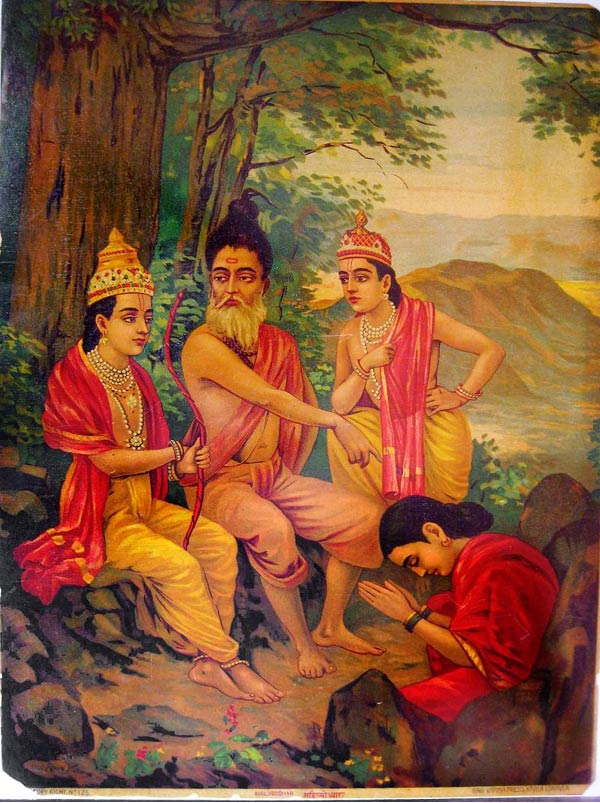
Rama releasing Ahalya from curse. Lakshmana and sage Vishvamitra are present. (Public Domain)
Like the water, keeping a steadfast heart through difficult changes, Ahalya is the embodiment of patience.
Draupadi was born of fire. She was the queen and wife of the five Pandava brothers who were rulers of Hastinapura, and heroes of the Mahabharata.
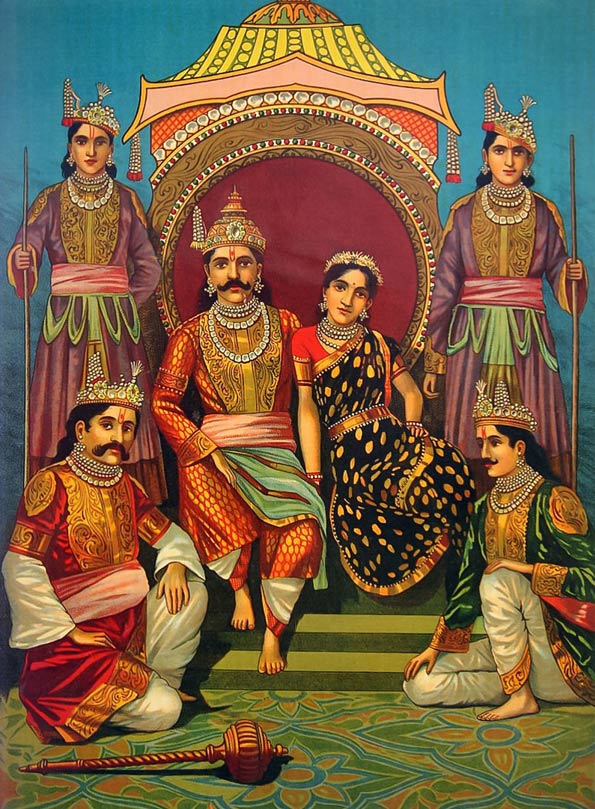
Draupadi and Pandavas. (Public Domain)
Draupadi was humiliated and very nearly molested in public court by the Kauravas, cousins and mortal enemies of her husbands. The Kauravas invited the Pandavas for a dice game and cheated them by playing with loaded dice. The Pandavas lost everything they had. They finally staked their common wife Draupadi and also lost her.
Draupadi was dragged by her hair like a slave into the royal court by one of the Kauravas. None of her husbands came to her rescue as she appealed to them.
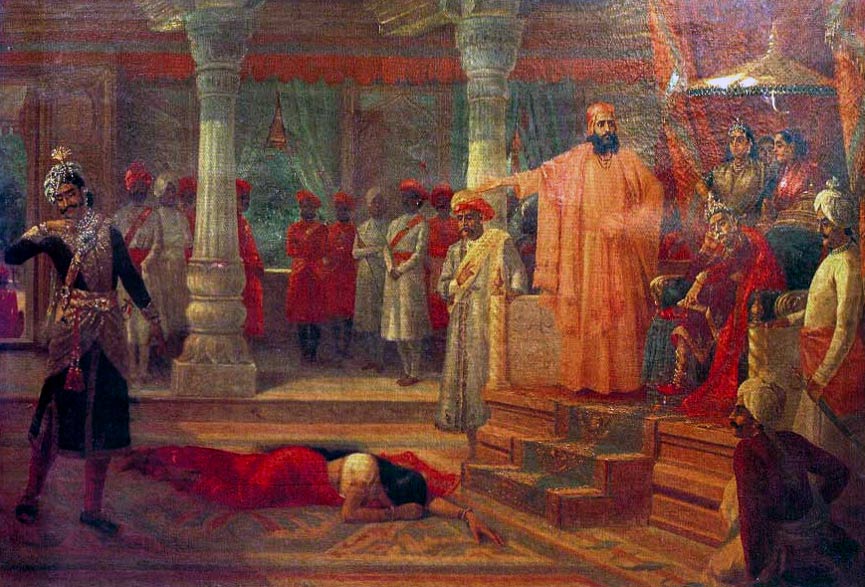
Draupadi as humiliated in Virata's durbar by Kichaka (left). (Public Domain)
As one of the Kauravas snatched at her garment while her husbands sat powerlessly on the sides, Draupadi cried out to Lord Krishna, the eighth incarnation of Vishnu. Krishna then blessed her, making her garment stretch endlessly till her exhausted tormenter collapsed to the ground.
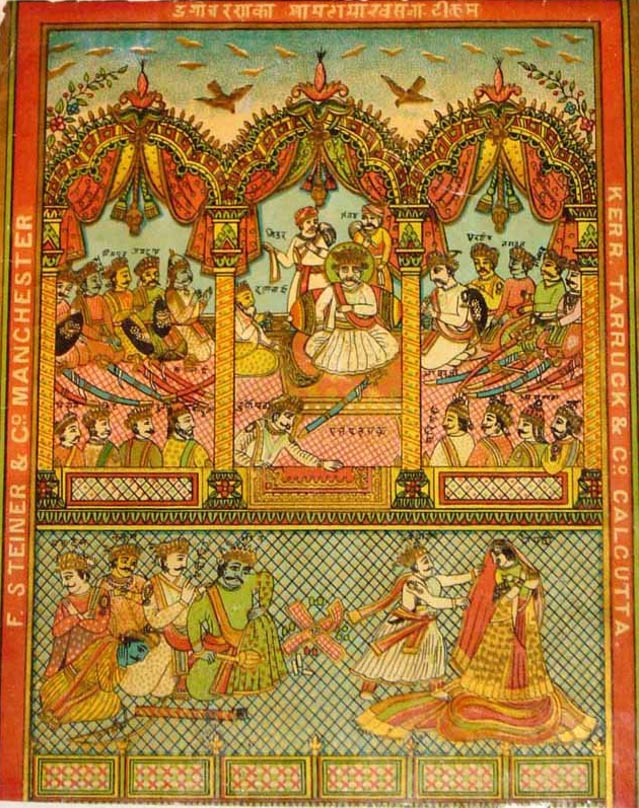
The disrobing of Draupadi, with endless reams of fabric (c.1900-20) (Public Domain)
With her fiery temper, Draupadi never hesitated to lash out at her husbands, her family, and even at Lord Krishna to remind them of their duties. Loyal to her husbands until the end, Draupadi managed to achieve the impossible task of being married to five men, keeping together five different personalities, uniting them and focusing their energies towards a great goal.
Brave and bold like a jet of flame, Draupadi is the embodiment of courage.
Sita was born from the earth goddess Bhumi. She was the wife and queen of Rama. Later renditions of Ramayana may paint Sita in softer tones, but Sita was actually a headstrong woman who argued her case with Rama and her in-laws to follow Rama into exile.
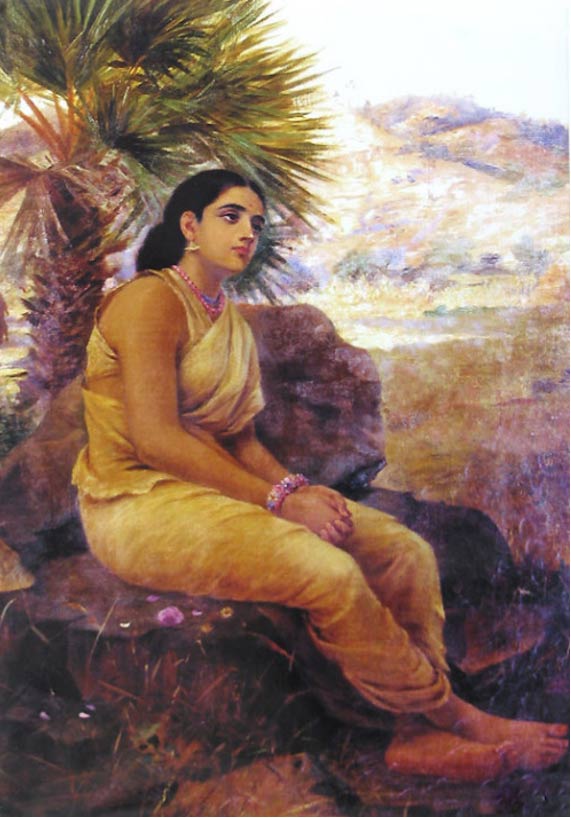
Sitas Exile by Raja Ravi Varma (1848 - 1906) (Public Domain)
While in exile, she proved herself able to live in the forest without a word of complaint, even though she was a princess. While in exile, Sita was abducted by Ravana, the giant king of Lanka. Sita was finally rescued by Rama in the war in which Rama slayed Ravana. Rama and Sita then returned to Ayodhya, where they were crowned as king and queen. However, Rama abandoned Sita, who was pregnant with his child at the time, when one of his subjects expressed doubt over her chastity, as she was abducted and was forced to live with Ravana, a man who was not her husband. Sita was then sent away to a hermitage where she gave birth to twin sons Lava and Kusha.
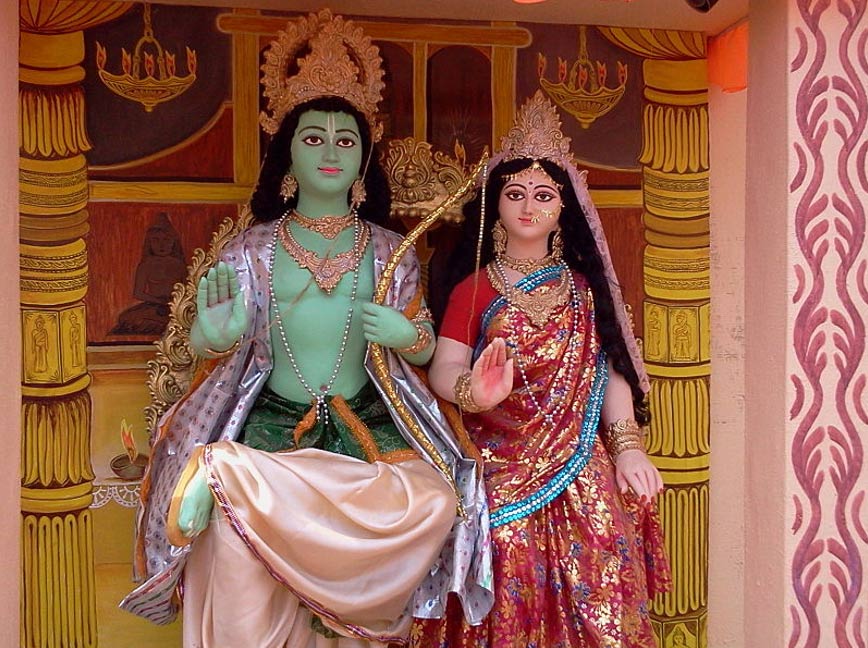
Rama and Sita (CC BY-SA 3.0)
She never asked for assistance, compensation or compassion from her parents, in-laws and Rama. After reuniting her sons with their father, Rama, Sita returned to her mother, the earth's womb, to release herself from a cruel world and gave one last proof of her purity.
Solid, grounded and calm like the earth, Sita is the embodiment of dignity.
Tara, a celestial nymph, was born of the wind. She was the wife of Vali, the mighty monkey king of the kingdom of Ishkindha.
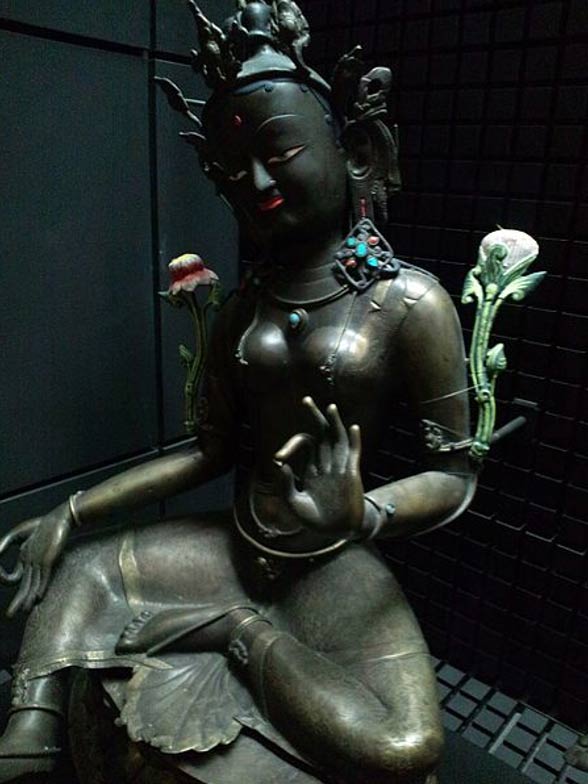
Osaka - the goddess Tara - Kathmandu in Nepal. (CC BY-SA 3.0)
Tara was an able administrator, and her knowledge of the kingdom was keener than that of Vali. She knew of Rama’s friendship with Vali’s brother Sugriva, Vali’s enemy. Despite her best efforts to dissuade Vali from antagonizing his brother, Vali fought the new alliance of Rama and Sugriva and lost his life, killed unfairly by Rama. Tara bravely stood before Rama and accused him of unjust slaughter, mocking the god-king’s lack of valor. Rama consoled her by saying that Vali deserved his death, as he had abducted another man's wife. Rama offered her Sugriva in marriage instead. Tara accepted the passing of her husband and married Sugriva, who then became the next king of Ishkinda.
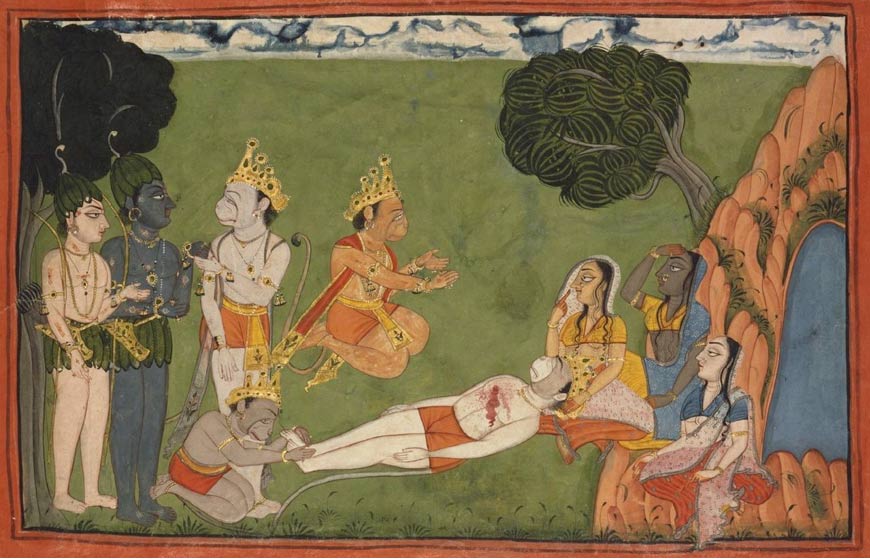
Vali dying. This scene from the Ramayana series is the climax of the struggle for rule of the monkey kingdom. Circa 1720. (Public Domain)
As it usually happened in history, a new king would dismiss the sons of his predecessor and insist on his own children becoming successors to the throne. However, Tara was said to champion her son’s right to inherit the throne of Ishkindha. She made Rama and Sugriva guaranty her son’s succession to make up for the dishonorable way they had killed her husband. She continued the diplomatic pressure in this new alliance between herself and her new husband to make sure her son would not be the loser in the new rule.
Quick like the wind, always finding her way, Tara is the embodiment of resourcefulness.
Mandodari was born from the sky. Daughter of a demon king and a nymph, she was cursed as a female frog, living in a forest near the hermitage of a sage.
One day, while the sage was away, she saw a snake spill its poison into the sage's bowl of milk. To save the sage's life she jumped into the bowl of poisoned milk and instantly died. The sage returned and saw the dead frog. To reward the good frog, he sprinkled sacred water over her and said a prayer to revive her into the form of a beautiful woman.
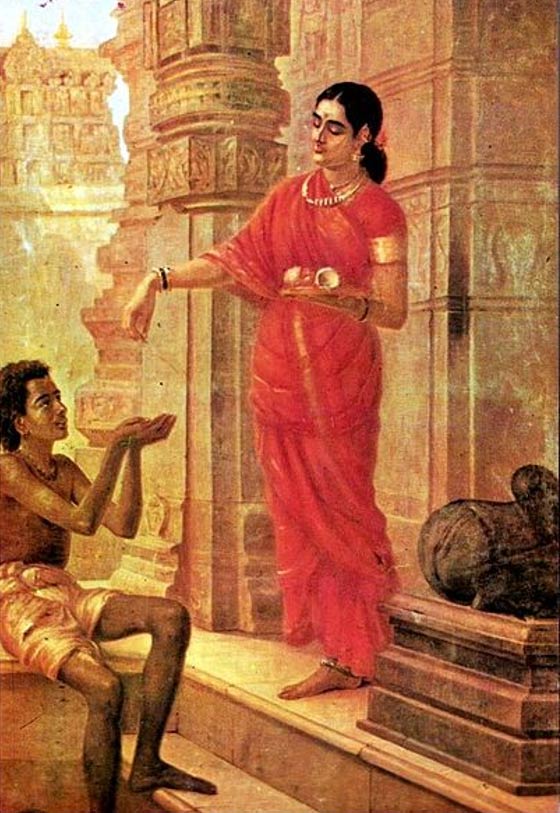
Attributed as Mandodari. (Public Domain)
Ravana, the ten-headed demon-king of Lanka, was enchanted by her and took her away to be his queen.
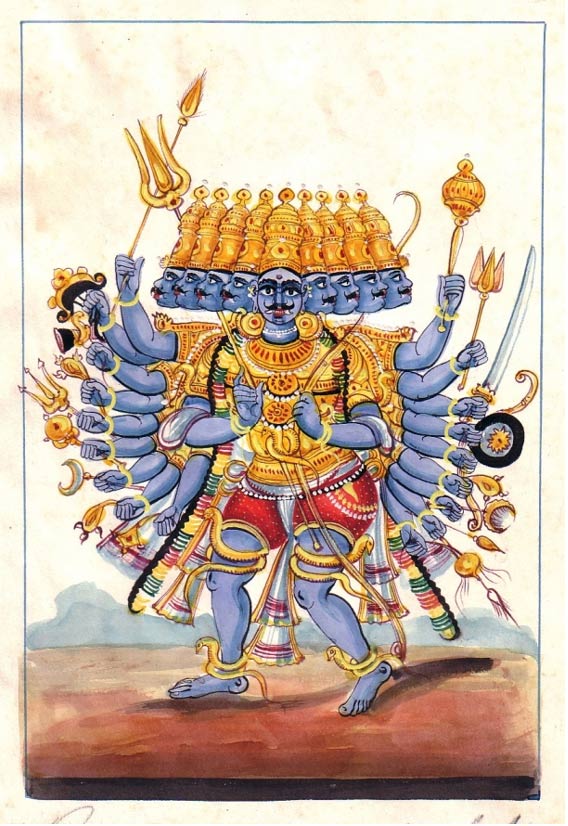
Ravana, the ten-headed demon-king of Lanka. (Public Domain)
Unfortunately, in her marriage, Mandodari had to contend with her husband’s roving eyes. Like Tara, Mandodari was very resourceful and knew statecraft better than most ministers. Therefore, Mandodari was able to keep her position as the chief queen amongst the many other wives of Ravana. Despite her delicate position, Mandodari exercised gentle yet great control over Ravana and was a moderating influence over his tempestuous nature.
Years later Ravana abducted Sita, wife of Rama, and Rama went to Lanka to wage war against him. Mandodari had a premonition of Ravana's fate and tried dissuade him from the war. However, Ravana refused to listen to her. Ravana knew he was invincible and no one could kill him except with his own weapon. Therefore, Hanuman, Rama's general, came in the guise of an astrologer and told Mandodari that she must worship a certain pillar to ensure her husband's victory. Mandodari unwittingly showed Hanuman which pillar held Ravana’s weapons. While Mandodari went to fetch the worship ingredients, Hanuman broke open the pillar and stole the weapon hidden inside.
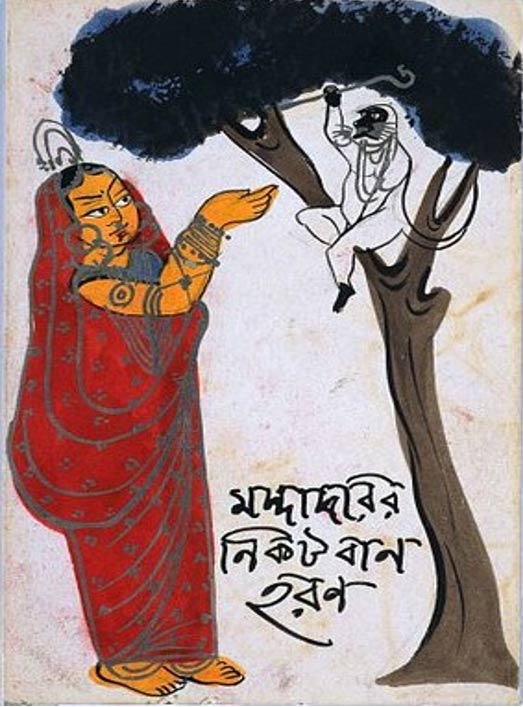
Hanuman obtaining Mandodari's weapon. (Public Domain)
Rama finally slew Ravana with Ravana’s own weapon. As the grief-stricken Mandodari mourned Ravana’s death, Rama blessed her for her loyalty to her husband. Indeed, had Ravana followed her advice, he would not have lost his life. Rama then gave her Vibhishana, Ravana's younger brother, in marriage.
Bright, vast and loyal like the sky, Mandodari is the embodiment of diplomacy.
Kunti – The Embodiment of Motherhood
It often happens that Kunti would take the place of Sita in the Panchakanya. In fact, one can argue that Kunti appeared in the prayers for the Panchakanya almost as often as Sita. Kunti, like Sita, also represents the Earth. Her childhood name was Pritha, which literally means “earth”. Even as an adolescent, Kunti was known for her hospitality and thoughtful ministrations to the guests of her royal adopted father.
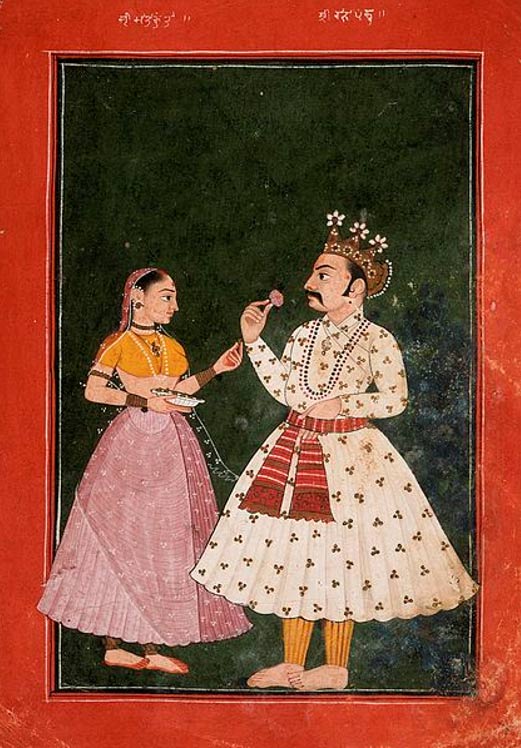
Raja Pandu and Kunti, circa 1680. (Public Domain)
It is said that one day, she pleased the sage Durvasa with her service and was presented with a boon which could summon any god in order to beget a child. Young and curious, Kunti invoked the radiant sun god, Surya, who appeared before her and blessed her with a child named Karna. Still unmarried and fearing of bringing disgrace to her clan, Kunti floated the child down the river. A few years later she was wedded to king Pandu of Hastinapura, who was cursed to die when he united with his wife. Pandu asked Kunti to invoke her boon and bear children through the gods, so that his royal lineage may be continued. Kunti, conscious of her duty as a queen, summoned the gods again and bore Yudhishthira from Dharma, the god of truth, Bhima from Vayu, the wind god and Arjuna from Indra, the king of the heavens. She then shared her boon with her co-wife, Madri, who bore Nakula and Sahadeva from the twin god of healing, the Ashvinis.
After the death of Pandu, Madri committed sati on Pandu’s funeral pyre, in which she burned herself to death to join her husband in the afterlife.
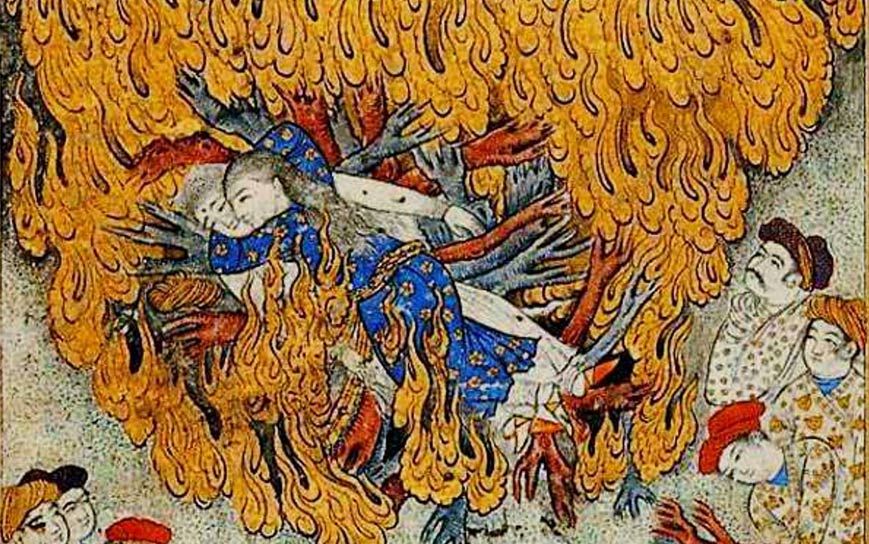
17th century illustration of a woman committing sati: self-immolation on her husband’s funeral pyre. (Public Domain)
Kunti was then left alone with five sons to look after. Kunti returned to Hastinapura with hers and Madri’s sons, both of whom she loved and cherished as if they were her own, for the rest of her life. Fearing that the Pandavas would take over their kingdom, the Kauravas, the princes of Hastinapura and cousins of the Pandavas, tried to kill Kunti and her sons. However, Kunti and her sons escaped.
She prevented Bhima from killing the giantess Hidimbi and forged an alliance with the giants. She instructed her children to take care of the common people even when they themselves had nothing. When Arjuna won Draupadi’s hand, Kunti was the one who instructed the brothers to share Draupadi as a wife.
Before the war between the Pandavas and Kauaravas ensued, Kunti revealed to Karna – who was now a Kaurava general – that she was his mother, and got him to promise her that he would not kill any other Pandavas, except Arjuna. After the war, in which the Kauravas and Karna were killed, Kunti left for the forest and spent rest of her life in prayer. She was killed in a forest fire and attained heaven.
Like the earth, a nurturing friend of all that is living, Kunti is the embodiment of motherhood.
The Mahari Dance Tradition
From its earliest origin, the Hindu classical dance has been associated with religion as its inspiration and motivating force. Its priority was offering to the Deity being worshipped. As soon as the religious part was done, it became entertainment for the people. The ritual chanting of the words Gitam samarpayanrij vadyam samarpayami nrityam samarpayami (I offer my song, I offer my rhythm, I offer my dance) during worship is indicative of the fact that dance and music are essential components of the temples rites.
The tales of the Panchakanya remain popular motifs in the Mahari dance tradition of Orissi. This tradition equates the Panchakanya with the five elements. In it, all the women are hailed as mahasati (great and chaste wife), and are venerated to this day, despite some transgressions, according to the orthodox Hindu religion.
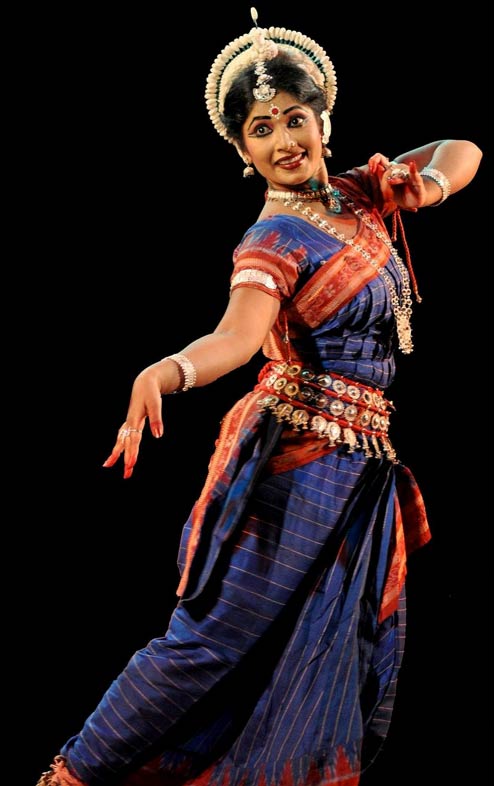
Mahari Dance is one of the important dance forms of Orissa. (CC BY-SA 3.0)
Ahalya was seduced by a man other than her husband, Draupadi had five husbands, and Sita, for a time, lived with a man who was not her husband. Tara and Mandodari both married the younger brothers of their husbands – unions which are still against custom in Hindu society. Kunti’s first child was born out of wedlock and none of her sons were her husband’s legitimate son. Without concerning oneself with the whys and wherefores of those “transgressions”, each of those stories remains a vivid reflection on the comparative broad-mindedness of Hindu religion in the ancient times.
The Women who were Thousands of Years Ahead of Their Times
The Panchakanya are all said to have had supernatural births, and were born without the involvement of the matrix of a mother’s womb. Kunti, who was the only one with a mother, was given away for adoption at birth and separated from her mother. Each of them experienced the disappointment of love and the agony of loss. Ahalya was raped, Draupadi had multiple husbands, Sita was accused of having sons by another man. All three women were abandoned by their husbands at one time. Tara and Mandodari’s husbands did not listen to their advice and were killed, leaving them to marry their respective younger brother-in-laws.
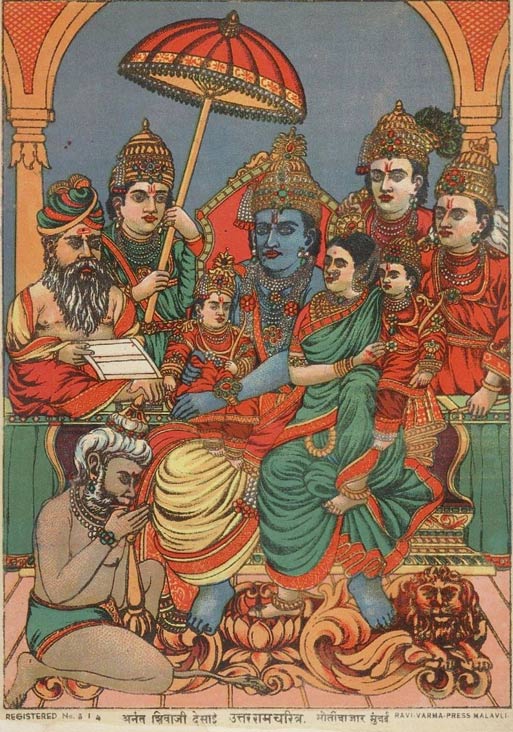
Legendary figures of the Ramayana. Rama with Sita on the throne, with their children Lava and Kusha on their laps. Behind the throne, Lakshmana, Bharat and Shatrughna stand. Hanuman bows to Rama before the throne, Valmiki is to the right. (Public Domain)
The Panchakanya, in the oldest tradition of their stories, were not the perfect ladies depicted in novels, movies and popular folklore years later, but they are the embodiment of great wives as listed in ancient texts of India. Descriptions of wives who were softer only developed later on by poets who developed a more romantic image of what it means to be a woman and a wife. However, the ancient descriptions of womanhood were more in keeping with realities of the modern age.
Featured image: The Five Maidens – Panchakanya (Public Domain)
References
B. Shah, “Panch Kanya – Ideal Wives!” Sulekha.com [Online] Available at: http://creative.sulekha.com/panch-kanya-ideal-wives_384308_blog
Bhattacharya, P., “Panchakanya: Women of Substance”, Journal of South Asian Literature, Vol. 35, No. 1/2, Miscellany (2000), pp. 13-56
Chaitanya, S., “The Willing Woman: On Women and Will Power” Indian Literature, Vol. 53, No. 5 (253) (September/October 2009), pp. 183-198
Devi, R., “Five Tragic Heroines of Orissi Dance-Drama: The Pancha-Kanya Theme in Mahari “Nritya”” Journal of South Asian Literature, Vol. 12, No. 3/4, Feminine Sensibility and Characterization in South Asian Literature (1977), pp. 25-29
Kelting, M. W., “Good Wives, Family Protectors: Writing Jain Laywomen's Memorials”Authors(s): M. Journal of the American Academy of Religion, Vol. 71, No. 3 (Sep., 2003), pp. 637- 657